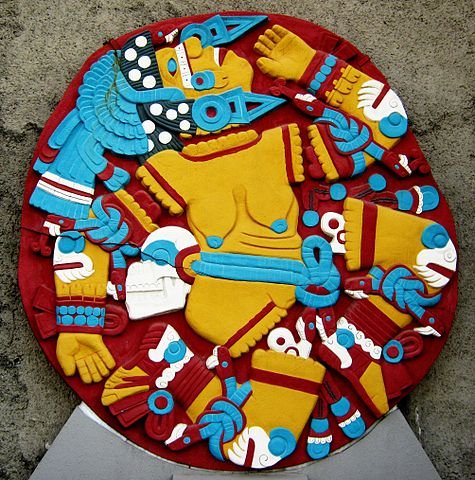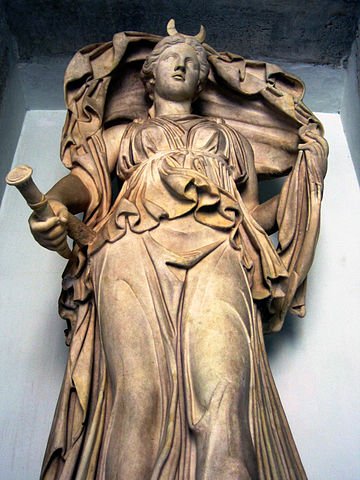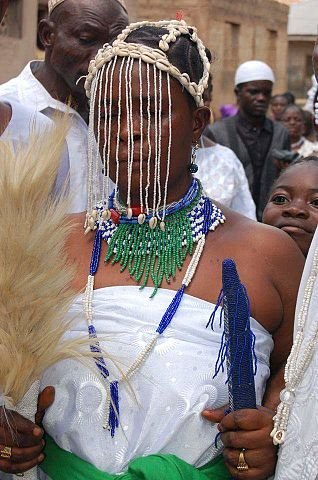People have always felt the energy and power that the moon has and its pull on the earth. It was natural for our ancestors to assign female deities to harness that power to help humankind.
Many ancient people had female deities of the moon. These moon goddesses typically aided farmers, helped women give birth, and protected us from negativity. Basically, the things needed for the people to physically survive.
Regardless of what gender you identify with, learning about the moon goddesses helps us all to find a balance between the masculine and feminine. The moon is cleansing, renewing, and helps us along our spiritual path.
Amesemi
Egyptian/Sudan
Amesemi was a goddess of the Kingdom of Kush in Nubia along the southern part of the Nile. She wore a crown that was shaped like a falcon. The falcon stood upon a crescent moon. Her husband was Apedemak, the lion-headed warrior God.
2. Cerridwen
Celtic
The goddess of the underworld and the keeper of the cauldron of knowledge. She imparts wisdom and knowledge, and intuition. She is considered the Celtic goddess of rebirth, transformation, and inspiration.
Her children, Creidwy and Morfran, represent light and darkness. She had a third child, Taliesin, who became a gifted poet. Cerridwen is known for being a helicopter parent and interfering in the lives of her offspring!
As well as the moon she is associated with herbology, fertility, science, prophecy, and poetry.
The Coyolxāuhqui stone which lied at the base of Huēyi Teōcalli (Temple Mayor) in Tenochtitlan, which is a replica of the original mountain of Coatepec. The stone depicts her dismembered and fragmented body.
3. Coyolxauhqui
Aztec
Coyolxauhqui, whose name means Golden Bells, because her dress is decorated with bells and symbols of the moon. She was at war with her brother Huitzilopochtli because she led her 400 brothers in an attack against their mother. Her mother Cōātlīcue, goddess of the earth was pregnant and Coyolxauhqui felt she dishonored them all.
Without exception, she lost in their combat and is often portrayed as dismembered. The moon is felt to be her dismembered head which her brother threw up into the sky.
Goddess Diana hunting statue at Brookgreen Gardens. Artist Paul Howard Manship. Photo by Doug Coldwell
4. Diana
Roman
Diana was the equivalent of the Greek goddess Artemis.
She is a young, beautiful woman, and often seen surrounded by animals. She is the goddess of the hunt and both wild and domestic animals.
Diana is also the goddess of pregnancy and childbirth two aspects of life closely related to the moon. This protection included pregnant dogs and livestock.
Originally she was not associated with the moon but as she became more closely identified with Luna and Hecate became associated with the moon. Starting in the late 6th century BCE the Diana triformis, or triple goddess formed, Diana as a huntress, Diana as the moon, Diana of the underworld.
5. Hanwi Sioux
Native American Sioux
Hanwi means “Night Sun” and she is married to Wi, the Sun god. Just like the moon pierces the darkness of the night it is believed that Hanwi pierces the darkness of your soul and protects you from negative beings.
Hanwi’s husband dishonored her by allowing a mortal to take her seat in the sky. So she often hides part of her face in shame, thus allowing for the phases of the moon.
Hanwi is also the Goddess of motherhood, feminine power, and watches over women during their monthly cycle.
Unknown artist, after Tang Yin (1470–1524) - The Moon Goddess Chang E. New York: The Metropolitan Museum of Art.
6. Heng - o (Ch'ang-o)
China
Referred to as the "Moon Fairy" and lives in the "Moon Basilica of Widespread Cold." Her equivalent is Thearch.
She is known for stealing the elixir of immortality from her husband, Hou Yi. He chased her in anger and she ran to the moon to escape.
The Chinese believed there were 12 moons and Heng-o is the Mother of the moons. She watches over relationships and is the goddess of devotion and manifestation.
In Ancient Chinese philosophy, the moon is a visual token of Yin, a cold white phosphorescent body associated with snow, ice, white silk, silver, and white jade.
Consider honoring her while doing a love spell. Heng-o is honored in China during the mid-Autumn festival.
Learn more about Heng-o and check out a love spell in our blog about her.
7. Hjúki and Bil
Nordic/Germanic
Hjúki and Bil are a brother and sister who together follow the moon through the sky. They are considered a minor significance as compared to Mani. They are written about by historian Snorri Sturluson.
They represent the phases and craters of the moon. Hjuki represented the waxing moon and Bil the waning moon.
In one version of the story, they are human children abused by their father and forced to work very hard. While out to gather water in a pail the Moon God, Mani, swoops down and brings them to live with him on the moon.
8. Huitaca
Columbia, South America
Huitaca was the goddess of the moon, witchcraft, sexuality, and music. She was considered a party girl and often compared to the Roman God Bacchus.
She brought rain to the fields and farmers worshiped her to bring fertility to livestock and plentiful crops.
According to various legends, she was either the wife or daughter of Bochica. Bochica oversaw law and order. He transformed Huitaca into an owl because she was not obedient.
Another version is she annoyed the Earth goddess Bachué, who was horrified at her drunken behavior and turned her into an owl.
9. Ix Chel
Maya
Her name means Lady Rainbow and she has a duo appearance. A young, sensual woman that is associated with fertility and sensuality (the waxing moon), and a powerful older woman associated with death and the destruction of the world (the waning moon).
Ix Chel is the goddess of love, gestation, medicine, and the textile arts as well as the moon. She was married to the God Itzamná and together they had 13 children.
Her feast day, Ihcil Ixchel, happens during the Mayan month of Zip and is celebrated by Shamens.
A temple built for her is still standing on Isla Mujeres (island of women). She is associated with the jaguar.
10. Ilargi
Basque (a region in Spain and France)
The goddess of the moon and the daughter of Mari, Mother Earth. The Basque people strongly contested Christianity and refused to give up their pagan customs well into the Middle Ages.
The Basque were farmers are very close to the cycles of the moon. Many rituals involving IIargi have survived. She oversees hidden knowledge, divination, and magic.
Ilargi is also the guardian of the dead; she leads their way to the otherworld.
11. Lona
Hawaii/Polynesian
Lona, sometimes referred to as Hina or Sina, was married to Aikanaka. Aikanaka was a mortal. Hina was the Mother Goddess who pulled the Hawaiian Islaslands up from the depths of the ocean.
As the ruler of the moon, she protects women below, offering them guidance through the cycles of life.
The words Sina and Hina both mean white. She is known for riding a white dolphin and causing Tsunamis.
Hina Hanaia-I-Ka-Malama means “the woman who worked in the moon”. Accordingly, Hina has many variations but her most worshipped form is that of Hina-i-ka-malama, or Hina-in-the-moon.
In Samoa, she is referred to as Sina and lives in a grove of trees in one of the dark spots of the moon. She created and named the birds of the islands.
12. Luna (Artemis, Selene)
Greek
During different periods in Greek history, the Moon Goddess may have been called Luna, Artemis, or Selene.
Selene drove a chariot drawn by two white horses through the sky. Selene is associated with Helios, God of the sun.
Artemis is the goddess of the moon and equates with Apollo as the God of the sun.
13. Mama Killa
Inca
Mama Killa or Mama Quilla is the third most powerful deity in the Inca religion. Her mother was Viracocha, the creator goddess. She is the older sister and wife of the Sun God, Inti. Her children Manco Cápac and Mama Uqllu (Mama Ocllo) were the “founders” of the great Inca civilization.
Mama Killa was the goddess of the moon, marriage, menstruation, and considered a defender of women. She was also considered the founder of the calendar and time.
Known as a beautiful woman several temples were dedicated to her. One in Cusco, Peru survives.
One of my favorite stories from the Inca culture is about how the moon got dark spots. It is believed that a fox fell in love with Mama Killa because she was so pretty. The fox rose into the sky to be with her however she was so excited to see him she squeezed him tight against her, producing the dark patches we see on the moon.
14. Mawu (Maou)
Dahomey, West African
Mawa (Maou) is a creation Goddess who created the mountains, rivers, and all the animals. She is symbolized by the clay and the moon and is a goddess over creativity, inspiration, birth, passion, and Universal Law.
She is the daughter of the supreme female goddess, Nana Buluku, and the twin sister/wife of the God Lisa. Their son, Xevioso, is the God of Thunder.
15. Yemaya
Yoruba, Nigerian, Africa
Yemaya is also known as Yemaja, is a moon goddess governing providence, luck, water, and fertility. She is symbolized by the fish, the color blue, and the crescent moon. Her name means fish mother.
Yemaya is often portrayed as a beautiful mermaid. Motherly and protective she watches out for fishermen at sea. It is said that humans were created when her water broke creating the rivers and human life.
Author, Katherine Fox is our editor and one of our writers. She is currently raising a pagan husband and three children. They love getting outside and exploring the natural world.











Traditionally pagans have celebrated life’s journey with rites of passage. The joining of two people in marriage is one of those passages. Today’s pagans want a wedding that reflects their values.